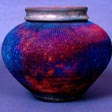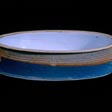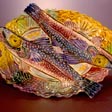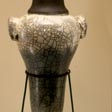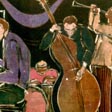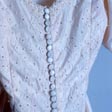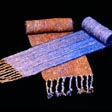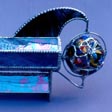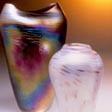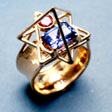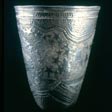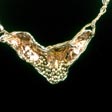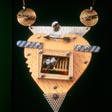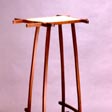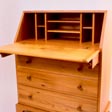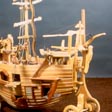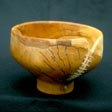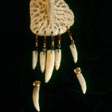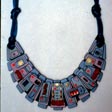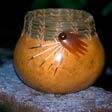Fait à la Main: About Louisiana Crafts

Revivalist and Contemporary Craftsmen
In 1972, only a handful of our state universities and colleges offered degrees in such individual craft areas as ceramics or glass. Many of our craftsmen received degrees but moved out of state. Many students came to study with some of the nationally known instructors here, but they too, left after completing their studies because of the limited market for their work. Since 1972, the craft movement in Louisiana has developed significantly, as evidenced by the various craft guilds and other similar organization in cities throughout the state. Now, several Louisiana universities offer graduate degrees in various craft media. Through festivals, workshops, crafts and arts galleries, Louisiana come to appreciate its craftsmen. As a result, university trained craftsmen are now staying in Louisiana after graduation. The potential for growth is now greater than ever. The Louisiana Crafts Marketing Program is evidence of that potential.
The resurgence of academic crafts grading across the United States and the appearance of apprenticeship in the studio have increased the numbers of contemporary craftsmen nationally. Some of these craftsmen such as ceramicists and glass makers have been drawn to Louisiana by the abundant supply of inexpensive natural gas needed to fire kilns, while woodworkers have been attracted to the rich variety of native timber in the state.
Revivalist and contemporary works represented range from the traditional to the avant garde. Revivalist craftsmen recreate pieces that are much like the designs of traditional works, often choosing the same materials and techniques as the original craftsmen. The revivalist is like the contemporary craftsmen in that he has acquired knowledge of his craft through books, workshops, and from a university education. While the contemporary artist concentrates on creating new designs and on innovative approaches and relations to materials, the revivalist incorporates less innovation in his work. His intention is to reproduce, in detail, works that are traditional in design—classic pieces such as Queen Anne chairs or Acadian kitchen tables. He differs from the folk craftsman in the way he as learned his skills in that he has not been taught by his family or community. While much research has been done on folk craftsmen in the state, there is little documentation on Louisiana's contemporary and revivalist craftsmen. Fait à la Main by no means includes all the contemporary craftspeople in the state, it does represent the diversity of the craft movement in Louisiana.
Ceramics
Most ceramicists in the program are university trained, many having received Bachelor or Master degrees in fine arts from schools such as Louisiana State University in Baton Rouge, University of Southwest Louisiana in Lafayette, and Louisiana Tech University in Ruston. Others studied at nationally recognized professional art schools or alternative education programs such as Glassel School of Arts in Houston, the Cleveland Art Institute, Rhode Island School of Design, and the Penland School of Crafts. In terms of style, program participants are developing contemporary designs rather than imitating styles of the past, although a few artists are reinterpreting such historical styles as deco and nouveau, or incorporating the influences of Japanese and Chinese traditions and techniques.
The majority of craftsmen in the program are producing stoneware and porcelain dinnerware and cookware. Porcelain and stoneware are more appropriate for cooking, being high fired and non-porous. Beyond dinnerware (mugs, goblets, plates) and kitchenware (covered casseroles, colanders, canisters), artists are producing lamps, vases, bird feeders and house, custom-made sinks, and purely decorative items such as figurines. Ceramicists working with terra cotta make architecturally-scaled pieces such as wall murals, tiles, and ornamental sculptures as well as functional planters and pottery.
Types of ceramic work in the program range from wheel-thrown forms to hand-built forms. Production pottery is more likely to be wheel-thrown because it takes less time, while hand-building lends itself to the creation of more unique forms, freeing the artist from the symmetry of the thrown form.
Overall, Louisiana ceramicists are exploring the sculptural possibilities for different three-dimensional shapes for the vessel itself and experimenting with techniques such as underglazing, glazing, color slips, smoking, carving, and piercing for surface decoration. Some potters run the gambit from straight wheel-thrown forms to manipulated-thrown forms to purely hand-built sculptural forms. Thus, Louisiana ceramicists offer a wide range of product styles and prices.
Fiber
Fiber covers any craft made from manipulating fibrous materials to create objects which may be wearable, decoration or utilitarian. Fiber craft techniques include spinning, dyeing, weaving and sewing, handpainting, and batiking fabrics. Products made using these techniques range from coarse fiber crafts, such as basketry, cane bottom chairs, and cornshuck dolls to fine weaving, such as pillows, shawls and tapestries, to fabric works such as clothing, table linens, quilts, and cloth dolls. The Louisiana Crafts Marketing Program has both contemporary and revivalist fiber craftsmen participating. The contemporary quilter, for example is one who stresses innovative design, color use, and pattern. Contemporary quilt designs range from geometrical optical illusions to scenic or fanciful landscapes, portraits or abstractions. The revivalist quilter, on the other hand, is concerned with the re-creation of traditional patterns with special emphasis on precise techniques in piecing and quilting.
In all of these media, as in any other part, the contemporary or revivalist craftsman must have knowledge of the elements of design: color, form, pattern, and texture. The weavers and other fiber craftsmen working with wearables may be as concerned with fashion design as they are with technique. Those who create fashion pieces work with the customer looking for the unique and timely. Color trends and style may dominate the design.
Contemporary basketmakers often incorporate a wider range of materials than the folk craftsmen. Often, they alter traditional materials by dyeing them. Texture and pattern may be created with brightly dyed pine needles or reeds. Other objects such s feathers, ribbons, or sea shells, give contemporary baskets a more fanciful, innovative look. While traditional baskets were created for a specific use, the contemporary basketmaker is more often concerned with satisfying the need for creating a unique aesthetic express.
Many fiber artists work with multiple fibers and a variety of techniques. A weaver often makes baskets; a spinner often weaves; a quilter often hand dyes or hand-paints some of the fabrics. The mastery of such interrelated techniques, along with the design elements of color, pattern, and texture, illustrate the versatility of Louisiana fiber craftsmen.
Glass
Louisiana glass crafts include both flat ("cold") and "hot" glass processes. The most common flat glass process is the construction of stained glass panels. Some artists are now transforming the surface and color with techniques such as etching, sandblasting, or laminating. These panels may be hung by themselves or incorporated into doors or room dividers. Some of the stained glass artists manufacture "hot" glass elements by slumping or fusing glass pieces for use in their panels. Typically cold glass artists work in large and medium-size pieces; however, some are combining both hot and cold processes to make small pieces such as jewelry.
Many of the cold glass artists here studied directly with or have been influenced by Paul Dufour, who developed one of the few graduate programs in the United States in stained glass at Louisiana State University. It has, unfortunately, been discontinued. Dufour and other glass instructors, and many of their students have received national and international recognition for their work.
While not as common in Louisiana as flat glass, hot glass works included in the program are of high quality. Molten glass not only allows artists to make blown vessels, but also to fuse and hold forms, allowing for greater sculptural variety. The degree program in hot glass directed by Gene Koss at Tulane University, and the New Orleans School of Glass promise even greater production and innovation in the process within the state.
Generally, contemporary glass craftsmen in the state, and nationally seem to be moving away from representational subjects toward abstract color designs emphasizing the luminous qualities of glass.
Metal
The metal crafts in this program range from the decorative work of jewelers to the utilitarian products of blacksmiths. Each uses different materials, techniques, and designs to execute a personal expression in metal.
The contemporary metalsmith draws on more techniques and materials than ever before. While new techniques and materials are important to Louisiana craftsmen, some metal craftsmen adhere more closely to traditional forms and techniques. Several jewelers use the traditional casting process of lost wax to produce silver and gold pieces. Other craftsmen use a wide variety of traditional techniques including enameling, granulation, repoussée engraving, metalspinning, and inlay to produce jewelry, cutlery, sculpture, decorative and utilitarian ironwork, hollowware, and even chandeliers. Some artists are reviving techniques which have practically disappeared.
Blacksmiths and knife makers are more likely to use traditional materials and techniques to produce revivalist forms. However, most of these craftsmen prefer to create original designs. For example, the forged steel knives of Shiva Ki, which reflect his understanding of the material he manipulates, respond to the contemporary artist's concern for unique design.
Although working in a larger scale and with less precious metals than jewelers, blacksmiths are also concerned with ornamentation. They often seek to create unique designs when forging such utilitarian objects as gates, fire pokers, racks, sconces, trivets, dinner gongs, triangles, and tools. Thus, blacksmiths, often considered the least delicate and most utilitarian metal crafts, reflect similar aesthetic concerns associated with the most delicately crafted jewelry.
Wood
The woodworkers featured in this section create a wide range of furniture, carvings, sculpture, clocks, instruments, and other items. Furniture makers, the largest group, construct works in a variety of styles. Many are revivalists, such as David Broussard who builds cypress furniture of simplified French design which was popular in colonial Louisiana. Many are as good as and, with better tools and materials, perhaps better than the early craftsmen whose work they reproduce. Some artists do not limit themselves to any one style or materials, preferring to work in both contemporary and traditional styles.
Contemporary furniture craftsmen are incorporating a rapidly expanding variety of forms and materials. New lacquers, plastic laminates, and primary color wood stains have given the furniture maker a new set of design resources. Rick Brunner produces one-of-a-kind sculptural wood furniture, boxes, and lighting that have a simplicity associated with Scandinavian and Oriental influences in furniture design.
Direct carving is another technique used by many woodworkers in the program. Some of the carvers offer whimsical pieces like Mickey McLean's ornate fantasy boat. Others create bas reliefs on doors, boxes, and mirror frames. Several craftsmen cave sculptural representations including human caricatures and plant and animal forms. Their interpretations and styles vary greatly. Wood lathing, common in furniture making, is also a technique used to produce decorative bowls and vases. Some laminate various woods to create intricate patterns to then produce lathe-turned wooden vases and bowls. Others, using native solid native woods, lathe turn wooden bowls.
Louisiana's rich variety of timber has, no doubt, proved to be a vital resource for artists working the state. This is evidenced by the emergence of the Louisiana Furnishing Industry Association.
Assorted and Mixed Media
Assorted and mixed media is a miscellaneous category for crafts which come in a variety of techniques and materials which are not part of other categories. The largest number of crafts in mixed media are doll makers who produce revivalist and contemporary styles of dolls. Porcelain doll making requires skills in both the use of fabric and ceramic materials. Reflecting Louisiana traditions and festivals, Lorraine Gendron gathers clay from the batture (the area between the bank and levee of the Mississippi River), to sculpt her dolls. The natural reddish color of the fired mud works well with the brightly colored acrylic paints and handmade clothing used to finish the dolls.
Other craftsmen use a wide variety of materials or incorporate found objects into larger compositions. Mary Ann Caffery produces a line of "technically exotic" jewelry incorporating milled plastic laminates, electrical parts, plastic toys, and assorted hardware. The craftsmen in this section simply do on fit comfortably into any of the more traditional craft categories. This is, in part, a tribute to their creativity and innovative use of materials.
Acknowledgements
This website edition of Fait à la Main is its third edition. The first edition was published in print in 1988 and edited by Maida Owens. The second edition was published in print in 1991 and edited by Greg Wirth. Over the years, many people have contributed to this effort. In the contemporary and revivalist craftsmen's sections, Greg Wirth, Genny Nadler, Mary K. Morse, Susan Roach, and Ann Russo contributed to the text. In the folk craftsmen's section, Ray Brassieur, Mary van Rheenen, and Adrian Gauthier contributed to the boat-building section; Marc Savoy contributed to the folk instrument section, and the research data of folklorists and anthropologists, especially Nicholas Spitzer, Maida Owens, Susan Roach, Ray Brassieur, H.F. "Pete:" Gregory, Don Hatley, and others for the other folk sections.


